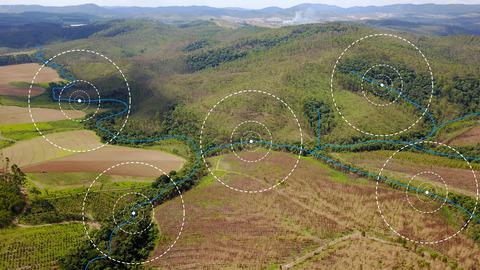当前位置:
X-MOL 学术
›
J. Appl. Ecol.
›
论文详情
Our official English website, www.x-mol.net, welcomes your feedback! (Note: you will need to create a separate account there.)
Thresholds of freshwater biodiversity in response to riparian vegetation loss in the Neotropical region
Journal of Applied Ecology ( IF 5.7 ) Pub Date : 2020-05-29 , DOI: 10.1111/1365-2664.13657 Renato B. Dala‐Corte 1 , Adriano S. Melo 1 , Tadeu Siqueira 2 , Luis M. Bini 1 , Renato T. Martins 1, 3 , Almir M. Cunico 4 , Ana M. Pes 3 , André L. B. Magalhães 5 , Bruno S. Godoy 6 , Cecília G. Leal 7 , Claudio S. Monteiro‐Júnior 8 , Cristina Stenert 9 , Diego M. P. Castro 10 , Diego R. Macedo 11 , Dilermando P. Lima‐Junior 12 , Éder A. Gubiani 13 , Fabiana C. Massariol 14 , Fabrício B. Teresa 15 , Fernando G. Becker 16 , Francine N. Souza 17 , Francisco Valente‐Neto 18 , Franco L. Souza 18 , Frederico F. Salles 19 , Gabriel L. Brejão 20 , Janaina G. Brito 3 , Jean R. S. Vitule 21 , Juliana Simião‐Ferreira 15 , Karina Dias‐Silva 22 , Laysson Albuquerque 23 , Leandro Juen 8 , Leonardo Maltchik 9 , Lilian Casatti 20 , Luciano Montag 8 , Marciel E. Rodrigues 17 , Marcos Callisto 10 , Maria A. M. Nogueira 24 , Mireile R. Santos 25 , Neusa Hamada 3 , Paulo A. Z. Pamplin 26 , Paulo S. Pompeu 27 , Rafael P. Leitão 10 , Renata Ruaro 28 , Rodolfo Mariano 17 , Sheyla R. M. Couceiro 29 , Vinícius Abilhoa 30 , Vivian C. Oliveira 3 , Yulie Shimano 31 , Yara Moretto 4 , Yzel R. Súarez 32 , Fabio de O. Roque 18, 33
中文翻译:

新热带地区应对河岸植被丧失的淡水生物多样性阈值
更新日期:2020-05-29
Journal of Applied Ecology ( IF 5.7 ) Pub Date : 2020-05-29 , DOI: 10.1111/1365-2664.13657 Renato B. Dala‐Corte 1 , Adriano S. Melo 1 , Tadeu Siqueira 2 , Luis M. Bini 1 , Renato T. Martins 1, 3 , Almir M. Cunico 4 , Ana M. Pes 3 , André L. B. Magalhães 5 , Bruno S. Godoy 6 , Cecília G. Leal 7 , Claudio S. Monteiro‐Júnior 8 , Cristina Stenert 9 , Diego M. P. Castro 10 , Diego R. Macedo 11 , Dilermando P. Lima‐Junior 12 , Éder A. Gubiani 13 , Fabiana C. Massariol 14 , Fabrício B. Teresa 15 , Fernando G. Becker 16 , Francine N. Souza 17 , Francisco Valente‐Neto 18 , Franco L. Souza 18 , Frederico F. Salles 19 , Gabriel L. Brejão 20 , Janaina G. Brito 3 , Jean R. S. Vitule 21 , Juliana Simião‐Ferreira 15 , Karina Dias‐Silva 22 , Laysson Albuquerque 23 , Leandro Juen 8 , Leonardo Maltchik 9 , Lilian Casatti 20 , Luciano Montag 8 , Marciel E. Rodrigues 17 , Marcos Callisto 10 , Maria A. M. Nogueira 24 , Mireile R. Santos 25 , Neusa Hamada 3 , Paulo A. Z. Pamplin 26 , Paulo S. Pompeu 27 , Rafael P. Leitão 10 , Renata Ruaro 28 , Rodolfo Mariano 17 , Sheyla R. M. Couceiro 29 , Vinícius Abilhoa 30 , Vivian C. Oliveira 3 , Yulie Shimano 31 , Yara Moretto 4 , Yzel R. Súarez 32 , Fabio de O. Roque 18, 33
Affiliation

|
- Protecting riparian vegetation around streams is vital in reducing the detrimental effects of environmental change on freshwater ecosystems and in maintaining aquatic biodiversity. Thus, identifying ecological thresholds is useful for defining regulatory limits and for guiding the management of riparian zones towards the conservation of freshwater biota.
- Using nationwide data on fish and invertebrates occurring in small Brazilian streams, we estimated thresholds of native vegetation loss in which there are abrupt changes in the occurrence and abundance of freshwater bioindicators and tested whether there are congruent responses among different biomes, biological groups and riparian buffer sizes.
- Mean thresholds of native vegetation cover loss varied widely among biomes, buffer sizes and biological groups: ranging from 0.5% to 77.4% for fish, from 2.9% to 37.0% for aquatic invertebrates and from 3.8% to 43.2% for a subset of aquatic invertebrates. Confidence intervals for thresholds were wide, but the minimum values of these intervals were lower for the smaller riparian buffers (50 and 100 m) than larger ones (200 and 500 m), indicating that land use should be kept away from the streams. Also, thresholds occurred at a lower percentage of riparian vegetation loss in the smaller buffers, and were critically lower for invertebrates: reducing only 6.5% of native vegetation cover within a 50‐m riparian buffer is enough to cross thresholds for invertebrates.
- Synthesis and applications. The high variability in biodiversity responses to loss of native riparian vegetation suggests caution in the use of a single riparian width for conservation actions or policy definitions nationwide. The most sensitive bioindicators can be used as early warning signals of abrupt changes in freshwater biodiversity. In practice, maintaining at least 50‐m wide riparian reserves on each side of streams would be more effective to protect freshwater biodiversity in Brazil. However, incentives and conservation strategies to protect even wider riparian reserves (~100 m) and also taking into consideration the regional context will promote a greater benefit. This information should be used to set conservation goals and to create complementary mechanisms and policies to protect wider riparian reserves than those currently required by the federal law.
中文翻译:

新热带地区应对河岸植被丧失的淡水生物多样性阈值
- 保护河流周围的河岸植被对于减少环境变化对淡水生态系统的不利影响以及维持水生生物多样性至关重要。因此,确定生态阈值对于定义监管范围和指导河岸带管理朝着淡水生物群的保护很有用。
- 利用关于巴西小溪流中发生的鱼类和无脊椎动物的全国数据,我们估算了原生植被丧失的阈值,其中淡水生物指示剂的发生和丰度发生了急剧变化,并测试了不同生物群落,生物群和河岸缓冲带之间是否存在一致的响应大小。
- 在生物群落,缓冲带大小和生物类别之间,天然植被覆盖丧失的平均阈值差异很大:鱼类为0.5%至77.4%,水生无脊椎动物为2.9%至37.0%,部分水生无脊椎动物为3.8%至43.2% 。阈值的置信区间很宽,但是对于较小的河岸缓冲区(50和100 m)而言,这些间隔的最小值要比较大的河岸缓冲区(200和500 m)要低,这表明土地用途应远离河流。同样,阈值发生在较小缓冲区中河岸植被损失的百分比较低,而对于无脊椎动物而言则非常低:在50 m的河岸缓冲区内仅减少6.5%的原生植被覆盖量就足以克服无脊椎动物的阈值。
- 综合与应用。生物多样性对原生河岸植被丧失的反应高度可变,这表明在全国范围内使用单一河岸宽度进行保护行动或制定政策时应谨慎。最敏感的生物指示剂可用作淡水生物多样性突然变化的预警信号。实际上,在溪流两岸至少维持50m宽的河岸保护区将更有效地保护巴西的淡水生物多样性。但是,为保护甚至更广泛的河岸保护区(约100 m)而采取的激励措施和养护策略也要考虑到区域情况,将带来更大的利益。该信息应用于设定保护目标,并建立补充机制和政策,以保护比联邦法律目前要求的河岸保护区更广的保护区。



























 京公网安备 11010802027423号
京公网安备 11010802027423号